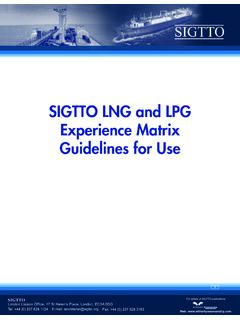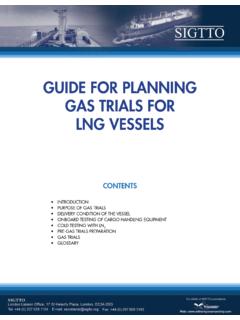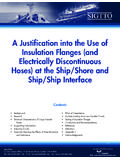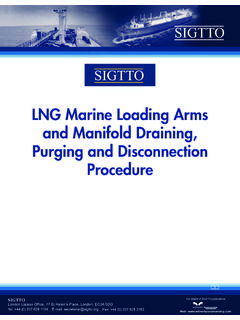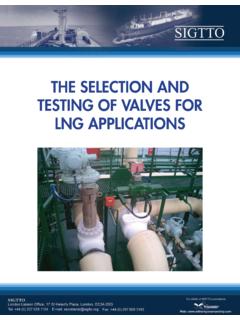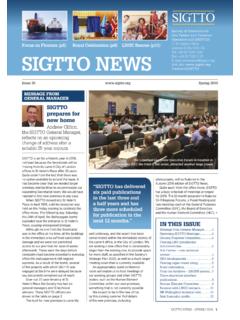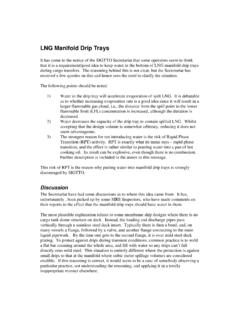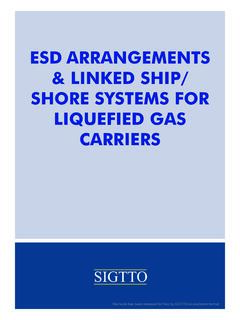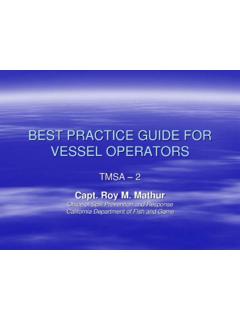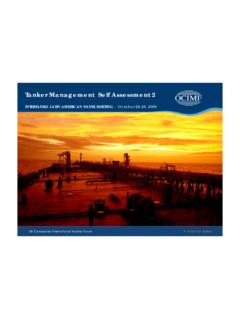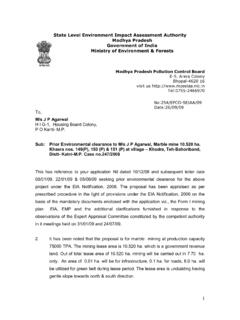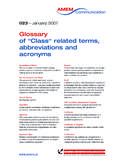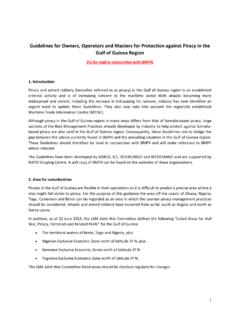Transcription of TRAINING RECORD BOOK - SIGTTO Website
1 TRAINING RECORD book . LNG SHIPPING. TRAINING RECORD book for LNG Shipping - Deck TRAINING RECORD book This document is provided as an example of a TRAINING RECORD book . Users are free to modify this document as required. 2. Table of Contents 1. Personal Details .. 4. 2. Introduction .. 5. 3. Guidance for the Trainee - For Completing this TRAINING RECORD book .. 6. 4. Guidance for the Master and Duly Authorised Officers .. 7. 5. Ship Service RECORD .. 8. 6. Shipboard TRAINING Officer/Master Review .. 9. TRAINING RECORD book .. 10. 3. 1. Personal Details Name (Full). Date of Birth Passport Number PHOTO. Seaman's Identity book Number Home Address Change of Address 1. Signature of the Candidate.
2 TRAINING RECORD book . Date of issue: .. Any other details the Candidate may wish to RECORD ( Next of Kin, contact details etc.): This TRAINING RECORD book is the property of the Candidate whose details appear above. If found, please return it to the latest address shown. 4. 2. Introduction Insert company specific text 5. 3. Guidance for the Trainee - For Completing this TRAINING RECORD book Insert company specific text 6. 4. Guidance for the Master and Duly Authorised Officers Insert company specific text Details of Officers Authorised to make entries in this TRAINING RECORD book . 1. 7. 5. Ship Service RECORD Signature of Type Sea Time IMO KW/Stm/ Rank/ Master Ship Name Membrane/ GRT.
3 Number Mtr/DFDE Capacity Joined Left Months Days Moss (dd/mm/yyyy) (dd/mm/yyyy). 8. 6. Shipboard TRAINING Officer/Master Review Date Ship TRAINING Officer TRAINING Officer's Master's Name &. Name and Initials Comments Initials Comments 9. TRAINING RECORD book Level Assignment Completed Criteria for Satisfactory Ship's Performance Name Management Operational Date Confirmed by Date Confirmed by Type of Assessment (Oral/Written/. Trainer (Initials) Assessor (Initials) Practical). I FUNDAMENTAL KNOWLEDGE AND UNDERSTANDING. Physics and Chemistry Have an awareness of the physics relating to the change of state of fluids Latent heat Heat and energy transfer Refrigeration and liquefaction of gases.
4 Critical temperature Diffusion and mixing of gases Know and understand the Gas Laws' and how they are applicable to LNG operations Pressure and temperature relationship . Know and understand the physics relating to the change of state of the various components involved in relation to LNG. Assuming atmospheric pressure, temperatures at which following components change from vapour to liquid: Butane Propane . Ethane Methane Nitrogen Behaviour of CO2 relative to other components Know and understand the principles involved in the changing of tank atmospheres Know the physics involved in the piston purge effect and stratification Know the methods that can be used to change tank.
5 Atmospheres Know which method should be used and explain why Have an awareness of the parameters for Inert Gas Oxygen content CO content CO2 content . Dew point The meaning of dew point'. Know the importance of dew point in cargo operations . 10. Level Assignment Completed Criteria for Satisfactory Ship's Performance Name Management Operational Date Confirmed by Date Confirmed by Type of Assessment (Oral/Written/. Trainer (Initials) Assessor (Initials) Practical). Know and understand the principles used during tank cool down process Know the principles for heat transfer . Know the principles for latent heat Principles of Design Have an awareness of main design principles Be aware of the principles for protection of cargo containment systems.
6 Know and understand the main design principles Know and understand the principles for protection of cargo containment systems . Regulations and Guidance Have an awareness of the applicable regulations IGC Code Classification Society Regulations . Flag State Regulations Know the relevant regulatory requirements for containment system and cargo related operations IGC Code Classification Society Regulations . Flag State Regulations Have an awareness of industry and organisational guidance publications available Liquefied Gas Handling Principles ISGOTT . ICS Liquefied Gas Tanker Safety Guide Safety Management System Have an awareness of industry sources of guidance and advice LNG Operations in Port Areas Ship Vetting and it's application to LNG.
7 Liquefied Gas Fire Hazard Management LNG Terminal Information Web Portal Principles of Tank Atmospheres Know the definitions relating to tank atmospheres Flammability range UEL. LEL.. Critical dilution 11. Level Assignment Completed Criteria for Satisfactory Ship's Performance Name Management Operational Date Confirmed by Date Confirmed by Type of Assessment (Oral/Written/. Trainer (Initials) Assessor (Initials) Practical). Properties of Materials Have an awareness of the materials that are used in the construction of LNG carriers and their properties which make them suitable for use Brittleness . Co-efficient of expansion Know and understand the materials that are used in the construction of LNG carriers Where individual materials are used.
8 Repair methods Hazards of LNG and Relevant Gases Have an awareness of the hazards to personnel and the vessel from LNG and relevant gases Cryogenic Flammability Oxygen deficiency . Flash point Auto ignition temperature Data sheets and MFAG for LNG. Know and understand the hazards to personnel and the vessel from LNG and relevant gases and the defences applied LNG . Inert Gas Nitrogen Know the First Aid action to be taken in the event of personnel contact with LNG. Skin contact Inhalation . Ingestion Have an awareness of LNG fire fighting techniques and equipment Use of high-ex foam Use of dry powder Heat intensity of LNG fires . Potential danger of extinguishing a fire prior to stopping the leak Know and understand LNG fire fighting techniques and equipment Process isolation and draining.
9 Water spray protection 12. Level Assignment Completed Criteria for Satisfactory Ship's Performance Name Management Operational Date Confirmed by Date Confirmed by Type of Assessment (Oral/Written/. Trainer (Initials) Assessor (Initials) Practical). Environmental Impact Have an awareness of the potential Environmental Impact of LNG operations Release to atmosphere . Consequences of cargo spillage Know and understand the potential Environmental Impact of LNG operations Planning to minimise emissions Monitoring operations to minimise actual emissions . Action to be taken to reduce environmental impact in the event of release Risk Assessment Have an awareness of the requirement to carry out risk assessments Definition of risk assessment and hazard Purpose of a risk assessment.
10 When to carry out a risk assessment Know and understand the process to carry out risk assessments of planned operations Risk assessment elements (process). How to identify hazards How to determine risk . How to establish likelihood and severity . How to decide if the risk is tolerable How to prepare a risk control action plan Individual Responsibilities Have an awareness of own responsibilities Carry out own responsibilities Report any defects or abnormalities promptly to the . appropriate person Know and understand own and others individual responsibilities Clearly delegate duties as appropriate to rank and ability Ensure that duties are fully carried out . Ensure that full and complete records are maintained Individual Responsibilities Have an awareness of their purpose and principles The role of contingency plans in non-standard and emergency situations.
